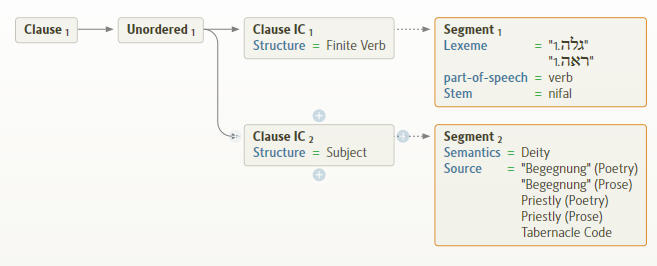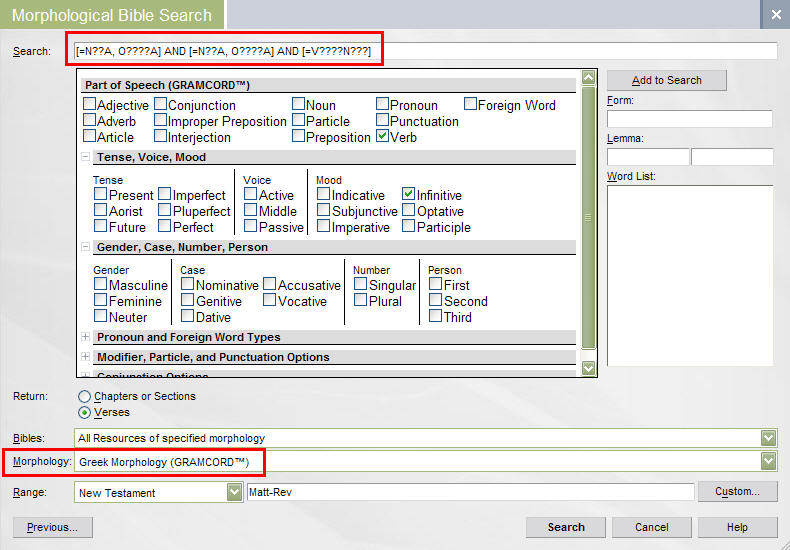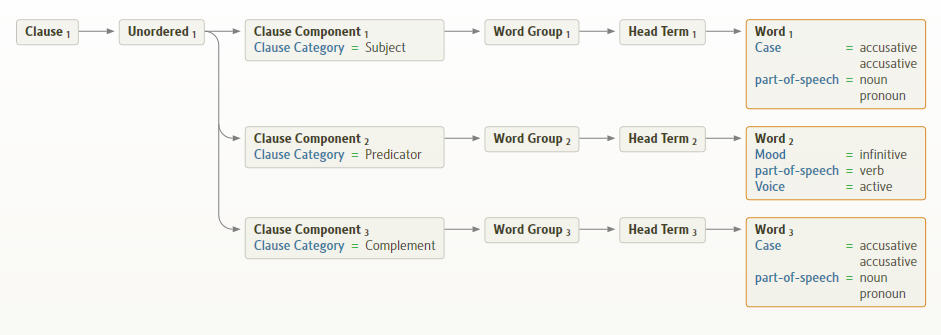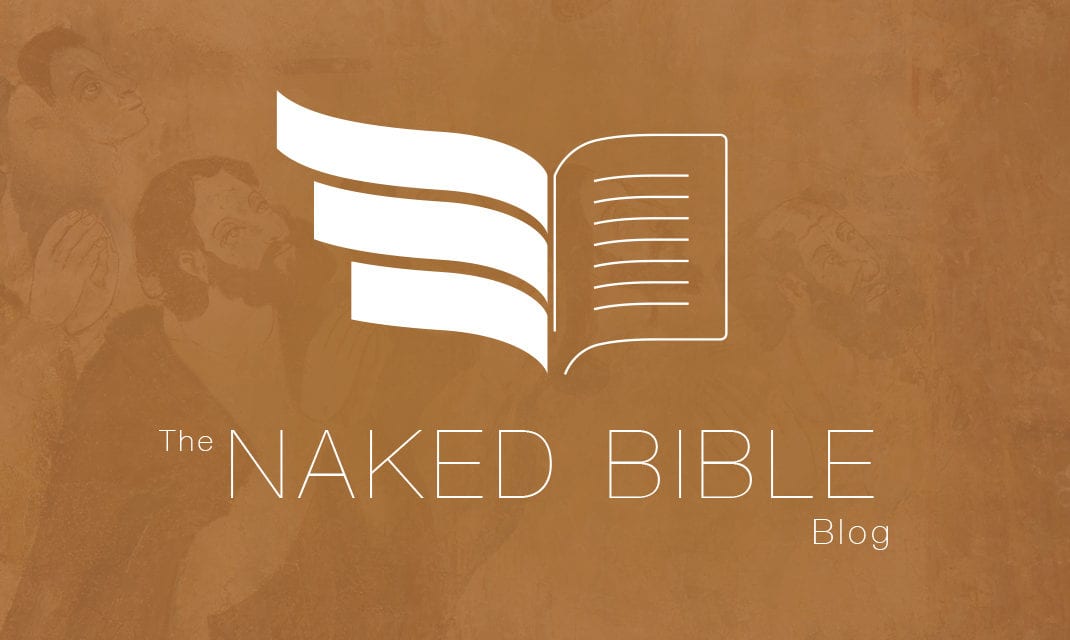I’m getting close to abandoning the discussion about software, at least for the foreseeable future. Hope those of you who don’t care about Bible software haven’t been bored by it all.
I haven’t made any attempt to scour the web for traffic about my initial Bible Software shootout post. Frankly, I don’t have the time and have better things to do with the little time I have. I have received some emails and have taken note of the comments on this site. One of the responses that keeps coming back is that syntax isn’t that important since (a) “our software company hasn’t had people begging for it”; or (b) I can’t see where I’d use it much in exegesis, sermon prep, or research; or (c) “I haven’t needed it up till now — my morphological searching serves me just fine, so who cares?”
These sorts of responses speak to the problem I noted at the end of my software shootout post. Every time something is pioneered, people don’t really know they’d want it and need it since they haven’t used it (because it hasn’t existed to that point). This is normal. Every innovation goes through this stage. In my lifetime, I can remember my own parents (or myself) wondering why anyone would want things like a computer, the intermittent wiper blade, highlighter pens, ATM machines, TV remotes, personal GPS, the Internet (my Mom still wonders that), and HD TV (I still wonder about that one since I don’t watch much TV). I can remember the first time my parents got a microwave oven. We assumed (for a very long time) that it was only useful for heating your coffee quickly when it got cold. It took a year or so before we realized you could make meals with it. Who’da thunk that?!
It’s easy to laugh at all this now. How short-sighted could we have been? Quite a bit it turns out. Syntactical databases are this way. So are Discourse databases (one of which we have for the entire NT, and which I didn’t even bring up before). Anything that moves people to think in NEW ways about OLD problems or needs is that way. For scholars who work in the OT or NT text, a lot of dissertation work currently being done is focused on syntax and discourse (and often those two are blurred). If you aren’t aware of this, you aren’t watching. Even dissertations that don’t focus on the text at that level have to interact with exegetes that approach the text at that level. More “normal” people — pastors and biblical enthusiasts — aren’t really being forced to consider such things, but their study and sermon content would be richer if they did (and they’d save a lot of time — something pastors really value).
In this post, I thought I’d give a few examples of what a syntax database can do for both groups. My aim here isn’t to show you searches that other software products besides Logos cannot do. That would be easy, and it’s unavoidable in the videos you’ll see below. My aim is to show that syntax queries are very useful. In what follows I’ll show some searches that would serve scholars/professors, and some that would be useful for pastors. The videos are each only a minute or two long.
(I’d also suggest that there is little to no subjectivity in the queries that follow. They are plain as day in what they ask for, since the syntax databases used below build on morphology while going beyond it.)
Scholars/Professors
1. Anthropomorphisms in P
I gave a presentation on this topic at a regional SBL a couple years ago. In the Anchor Bible Dictionary you’ll read this assertion in the article on the Torah:
“Blatant anthropomorphisms such as Gods walking in the garden of Eden (J), making Adams and Eves clothes (J), closing Noahs ark (J), smelling Noahs sacrifice (J), wrestling with Jacob (E), standing on the rock at Meribah (E), and being seen by Moses at Sinai/Horeb (J and E) are absent in P.” (ABD VI:611, R.E. Friedman).
Dr. Friedman is well known for his work in source criticism of the Pentateuch, but he is simply wrong here, as you’ll see when you watch the video below. It took me about five minutes to come up with the query in a syntax database that tested his assertion and found it wanting. The part of his quotation that struck me as suspicious was his notion that in P the anthropomorphism of being seen (Friedman uses the example of Moses at Sinai, J and E) are absent in P. So, in the query I ask for all the places in P where a deity is the subject of Hebrew galah and ra’ah in the niphal (both mean “to appear” or “be seen/revealed”). Here’s what the search looks like in Logos 4 (note how the Andersen-Forbes syntax database contains source-critical tags (“P” nomenclature from Eissfeldt) and tags for noun semantics (Subject: “deity”).

Here’s the video of the search. It took six seconds to show Dr. Friedman was wrong. We rightly think of syntactical databases being extraordinarily useful for testing assertions scholars make about grammar and syntax, but in this case, it provides a means to critique comments that affect source-critical understanding and Israelite religion. I have to wonder how Dr. Friedman missed these clear instances in P of exactly what he says isn’t in P. Maybe he doesn’t use software, or maybe he thought the task too time-consuming in his present software — looking up all the places in P where a deity name occurs and then seeing what that figure does. Sifting through all that might take a couple hundred hours, so (maybe) we can give him a pass.
2. Instances in the Greek NT Where the same Infinitive has BOTH a Subject (Noun or Pronoun) and a Direct Object (Noun or Pronoun) in the Accusative Case
Greek students know that the infinitive takes its subject in the accusative, not the nominative, case. It’s common since there are a lot of infinitives in the Greek NT. Morphological databases can’t find this, though, since they aren’t tagged for syntax (there are no “subject” tags on words). What they can do, though, is find all the places where an infinitive and a noun or pronoun in the accusative case co-exist in a verse. Then it’s up to you to sort through all the results to find the noun or pronoun accusatives that actually function as a subject to an infinitive. Dozens of hours of work. But the reference grammars can be cherry-picked for that sort of thing, and have been by professors looking for examples for teaching their syntax classes. But what if a scholar or doctoral student needed to find ALL the occurrences (to hopefully write a better reference grammar section on the phenomenon). What if a scholar or doctoral student wanted to find all the clauses where the infinitive’s subject is a noun or pronoun in the accusative and that same infinitive also had a direct object noun or pronoun in the accusative? That search calls for two instances of a noun or pronoun and an infinitive in a clause. For users of a morphological database, where there are no true clause boundaries and no tags for “subejct” and “direct object”, the query is basically pointless. Here’s what it would look like in GRAMCORD:

This morph search in GRAMCORD yields 5903 occurrences. There are just over 7900 verses in the NT. You get the picture.
In syntax databases a search like this is easy because of the syntax tagging. Here’s what it looks like in Logos 4:

Here’s a video of the search. From 5903 hits to 58 that actually matter.
3. Discourse Sequence1
Shortly after we developed the Andersen-Forbes database, we had a Hebrew professor visit our offices. His first question when we sat down to show him the new database was this: “Can you show me all the places in Judges where a wayyiqtol clause is followed by another wayyiqtol clause, and then a third wayyiqtol clause, and then that is followed by a disjunctive waw prefixed to a noun, which is followed by a perfect (suffixed) verb form which is the predicator of that noun?” Nice to meet you, too! We found out later he asked because his current software couldn’t do it (he’d even called their programmers) and he needed the information for a commentary he was writing, whose deadline was quickly approaching. Here’s what that query looks like in Logos 4.

Here’s the video of the search.
Pastors
1. The Righteous in the OT
Let’s say you wanted to create a sermon around what a righteous person does and does not do in biblical theology. There are three immediate obstacles that may or may not be apparent at the beginning of your prep, but which would surface pretty quickly:
A. The word occurs a lot. A speed search in my ESV reveals that “righteous” occurs 283 times in 265 verses. If a pastor neglected to avoid wildcarding in his search, so that all forms of righteous* are searched (e.g., “righteousNESS”), then the total jumps to 563 occurrences in 518 verses. It’s just too much to wade through.
B. Not only is the data overwhelming, but the data really didn’t give the pastor what he wanted. The sermon is about “the righteous” (righteous people) who do something or do not do something. He coudl change his search to “the righteous” and things get a little better: 163 hits in 157 verses. Probably not what the average pastor can handle anyway (I think we all know that pastors are often so time-constrained they’re lucky to get 5-10 hours a week for sermon prep). If that’s not you, consider yourself blessed.
C. Suddenly it dawns on the pastor that he did his search in English. He’d really like to be faithful to the text. Maybe he remembers enough from the Hebrew class he couldn’t wait to escape from to type in Hebrew. Maybe he remembers enough to realize that there will be Hebrew lemma differences between “righteous” (tsaddiq) and “righteousness” (tsedaqah, tsedeq). He may not recall that he really wants the former lemma. Regardless, his search will still require him to sift a lot of false hits. Why? Because his database doesn’t have words tagged for their function in a clause.2 What the pastor really needs is a way to search the text for all the places those lemmas appear as the SUBJECT of any verb. Those results will nearly all be germane to what he really wants for the sermon. For that, he needs a syntax database. Here’s what it would look like in Logos 4:

Here’s the video of the search. The search yields 58 occurrences.
Now, I can hear some of you already. “Come on, Mike, what pastor is going to be able to figure out how to make a search like that? Scholars can barely do it.” You’re right with respect to the user-unfriendliness of the database for the non-specialist. That’s precisely why we did two things in Logos 4: (a) We pre-loaded syntax templates that any user can start with and change by deletion or addition of query items; and (b) we run basic syntactical relationships under the hood, unseen, when a user clicks on “Bible Word Study.” The next video shows how someone who wouldn’t even think of constructing a syntax search could get syntactical information without even knowing it. (The next video’s right click method could have been the method for this “righteous” search as well).
2. What Did Jesus Do in the New Testament?
I know this sounds like an amazing simplistic search, but hold on to your hats. It’s a great example of how pastors (and even scholars) who have grown so used to “old” ways of searching with Bible software don’t really know what they’re missing by not having syntax databases. In the old technology, you’d only be able to search for “Jesus” — you couldn’t actually search for anything he did. You’d have to read through the 920 instances of the name “Jesus” (by ESV count) in the NT and read through all of them to see if Jesus is doing anything. Wouldn’t it be sweet if you could just find all the actions Jesus did in the NT? Now you can, and it’s so simple my ten-year-old can do it. Here’s the video — it’s great sermon fodder.
Here’s a note for after you’ve seen the video. If you *did* take a whack at using the syntax search interface, you could combine some of the verbs you saw in the grammatical relationships section of the Bible Word Study report and restrict it to only active verbs to get even more specific (and save more time).
3. What WILL Jesus Do in the Future?
This search builds off the one above, and I use the OpenText.org syntax database. I simply ask for clauses where Jesus (or “lord”) is the subject of a clause and the predicate of that clause is in the future tense and active voice. I exclude the Gospels and Acts from the search. There are 8 hits, and it would make for a good topical sermon. Here’s what the search looks like in Logos 4:

Here’s the video.
What the search doesn’t do is account for where Jesus says “I will do X” or where a writer says about Jesus “he will do X” (that is, it only accounts for expressed subjects). What we need for all that other detail is “pronoun disambiguation” — someone to go through and create tags on ambiguous pronouns and identify who / what the pronoun identifies. That’s on our to-do list – and it’ll make syntax searching even sweeter — and more practical (for even the scholar).
I hope these examples help you all see that syntax databases are pretty cool and useful. I took some heat for using the word “obsolete” in my shootout post of software packages that don’t have syntax databases. I’ll admit it was probably not the best word choice and a little over the top. Now that you’ve seen some examples, I’ll let you pick the word you want to use to describe the absence of these tools.
So, what can you do with a syntax database? A lot. These examples can’t even be said to scratch the surface. I’m working on an idea, though, that I hope will get scholars to give us direct feedback about what they’d like to see with these tools. I’ll keep you posted on that.
- I realize that this illustration isn’t what many would call “discourse.” I merely present the episode and the search; I’m not taking sides. ↩
- Note here that verse boundaries are artificial – you can have more than one clause in a verse. It is also artificial to use conjunctions to mark clauses, since that isn’t what conjunctions do by default. ↩





While I can appreciate you not having a lot of time, you made some bold claims in that bomb of a post on the “status quo”. I’m still very interested in understanding your claim that “the means of searching these titles is superior as well due to under-the-hood issues.” (in reference to secondary sources).
another question for you wasn’t this more an example of semantic tagging, not syntactical?
@Danny Zacharias: no, though semantic information is part of the syntax databases.
@MSH: also not sure specifically which search you refer to.
I like this this sort of posting – maybe you can post some more or at least some links that are free (because all though I would love to go to one of the workshops I just can’t afford it or find time for it) showing how to use the LOGOS software. Is there a cheat sheet or flowchart of some kind that I could buy that is affordable.
@Jason:
I’ll be making syntax tutorials in 2010 for 4.0, so there’s nothing now, but there will be.
Thanks for this. Very helpful to understand some applications of syntax searching. Looking forward to your future tutorials.
I replicated your Bible Word Study for Jesus from point 2.
In the Grammatical Relationships section of the Word Study, should the listings under the headings “Used Adjectivally” be swapped with the listings under”Modified by Adjective . . .”?
Michael,
I understand the idea “why would I need that?? when speaking of these new tools…
I’ve said it myself…but I thank you for these videos for at least disbursing part of the haze….
@Russ: are you running 4.0 or 3.0? If 4.0, what version?
@MSH
I am running 4.0a Beta 2.
Nice. Is there a way to do a little more advanced search on “What did Jesus do?” Some verses will not have “Jesus” or “Lord” as the subject, though he is the one doing the action. (They may use a pronoun or leave the subject implied.) I see in your first search you were able to specify Deity as the subject. Can we specify an individual, like Jesus?
There will be soon – we are disambiguating pronoun references at Logos, and at some point that work will be married to syntax searching.
Hi Michael!
I sure loved your logos 3 syntactical search videos, unfortunately I had purchased logos 4 and was desparate to find any help in constructing a syntactical search through the opentext syntactically analyzed greek database. As you know the user search interface is totally changed from logos 3; so while I gained valuable theoretical insight from your videos for logos 3 on the syntactical search dvd, the methodology for constructing searches was entirely changed for logos 4. You mentioned in a 12/7/09 reply that you were going to be making syntactical tutorials during 2010. May I ask if those plans ever became reality? I would love to buy them or find their wherabouts either on your website or somewhere else on the web. You have a slightly more deliberate delivery style that makes your videos much easier to understand than their other video demonstration commentators. Their delivery style doesn’t fit the audience (ME,a first time user who doesn’t know anything about Logos 4) I’ve always believed that the teacher who can put technical concepts into simple language that neophytes can understand know their subject the best and make the best teachers.
On a related subject,. I want to create a syntactical search that can locate every ‘object-complement’ in the accusative as a syntactical construct in the NT. I’m attempting to confirm Dan wallaces theory that “object- complement’ constructs in the accusative follow the same pattern for determination of their complement as the criteria laid out by goetchius grammar for determining subject and predicate in simple clauses with the copula. You created a syntactical search query Where the same Infinitive has BOTH a Subject (Noun or Pronoun) and a Direct Object (Noun or Pronoun) in the Accusative Case. if the predicator is changed to any finite verb, and the Subject as clause component was changed to Complement, would i get any closer to finding at least a handful? Amongst the examples Wallace provides in his article, I have noted that He has classified a few accusatives as the direct object which the diagrammed opentext citations reflect as Definers -i.e. a definer of the direct object would be the direct-object’s complement.- exactly opposite of Wallaces viewpoint, which I realize is the point of discussion for his article in the first place – How do we determine which is which. So this leads me to another question
Since grammarians disagree on relatively simple syntactical questions isn’t the worth of a sophisticated Syntactical search engine limited in it’s ability to find constructs by the linguistic training of the grammatical diagrammer of it’s database?
thanks for your help, keep up the Good work! Baker.
it’s actually still on the to-do list (for me or someone in the dept). It has such a low priority, though (few ask or indicate they want this) that it always seems to get shifted down the queue. I’ll take a closer look at your search on Monday in the office.